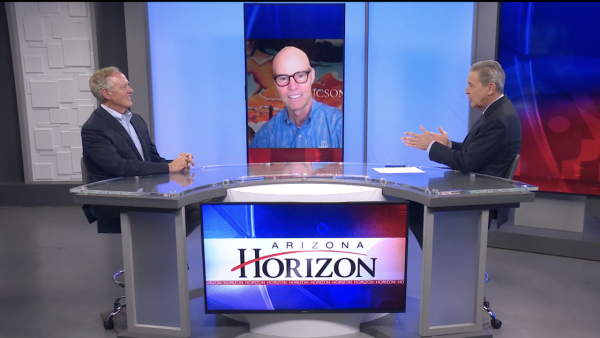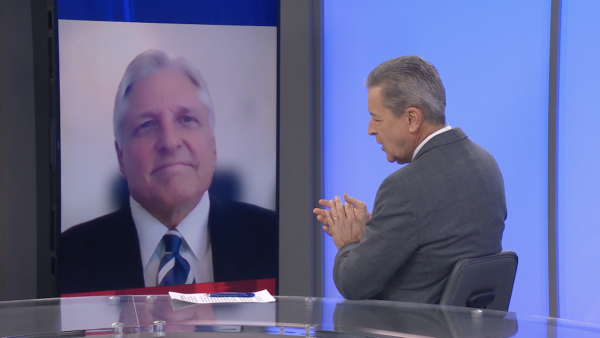Producer
As a producer at Arizona Horizon on Arizona PBS, part of my responsibility is writing short summary articles for each daily interview. The articles are then edited and posted on Arizona PBS’s website.
Russia invades Ukraine
Early this morning, Russia began a land, air, and sea invasion of Ukraine. Ukraine is now fighting on three fronts as Russian forces cross the border near Kharkiv in the north, Luhansk in the east, and the Russian-annexed Crimea in the south. Russia is demanding Ukraine’s armed-forces lay down its arms, but Ukrainian President Volodymyr Zelensky called on Ukrainians to defend their country. We spoke with Daniel Rothenburg for more ASU Center on the Future of War.
What do we know about the Russians military tactics as of right now?
Rothenburg: “One interesting thing about this conflict the U.S. decided to put the world on notice regarding the Russian plans, and they have more or less followed through on what we were told to expect. There have been rocket attacks, there have been armed columns. It started last night and it’s ongoing.”
It sounds like airfields and air defense are among the first things to be attacked, is this true?
Rothenburg: “True, and that’s also a classic strategy and something that the U.S. also did in the past. It makes sense to try to ground the opponents air force.”
How much could sanctions hurt Russia?
Rothenburg: “One thing that’s been interesting about watching all this from a distance is that the initial threats by Putin, Putin made a series of specific demands, and the U.S. and European allies decided not to cave into those demands but to express a unified front and to be very clear that punishing sanctions would be the result of additional military action. Those have just been announced. Its difficult to know exactly what those sanctions will have and nor have the most severe sanctions been put into place yet. Whatever happens with sanctions their impact takes more time. It isn’t like an invasion, so we have to sit back and watch and try to access what all of this means.”
What is to keep the Russians from turning to China?
Rothenburg: “Already seen moves in that direction. Again no one knows where all of this is going this is suggests some pretty powerful and significant realignments of global politics. It’s not clear that China is going to want to cozy up to Russiaon the terms that are of interest to Russia, but again there are a lot of things happening in the world and it is pretty early to make predictions on where this is all going.”
The fight for more equitable voting
On the 110th anniversary of Arizona’s statehood, Save Democracy Inc. launched to champion raising awareness of our electoral voting system and potential alternatives that treat all voters equally and give all candidates equal access to the ballot. Earlier, we spoke with former Phoenix Mayor Paul Johnson and Save Democracy Board Member Ted Hinderaker for more.
Save Democracy focuses on publicizing the negative impact of increased partisanship as a result of a two-party system.
Paul Johnson describes the system as unfair to voters–especially independents–as well as to candidates who are not running as Democrats or Republicans.
It leaves us with a “limitation on choices as voters,” Johnson said, and that today we are in a position where “the republic is being challenged.”
Hinderaker said only about 10% of voters select 80% of the state legislature, meaning the candidates do not have to answer to a wider swath of constituents. They only have to appeal to “primary voters” who Hinderaker said are typically “stubborn” voters.
Johnson said aspiring candidates have four or five months to get 7,000 signatures to become a Republican candidate, 6,000 signatures for a democratic candidate, or 40,000 signatures in 30 days for independents.
“Why?” Johnson asked. “Because they don’t want you to have a choice. They believe the two parties are entitled to being able to own the system.”
And Johnson said they are “not doing a good job with it,” adding that we are “then left to choose the lesser of two evils.”
Hinderaker compared the system to that of the Soviet Union’s in which the parties choose the elected officials, something he said “was not what our founding fathers envisioned.”
He added, the result is typically two candidates, one far right, and one far left, and a distinct lack of middle-ground choices.
Johnson said “the republic that our founders put together works; democracy works; the republic works,” but the two party system has evolved and poses a grave danger.
A New Bill Restricts How and When You Can Film Cops in Arizona
Recently Rep. John Kavanagh introduced HB 2319 to the Arizona House of Representatives which would prohibit anyone from recording the police in public without permission from the officer first, with few exceptions such as if someone who is “the subject of police contact.” This would afford police a reasonable expectation of privacy in public–a right not afforded to any other group in the country. Earlier, we mediated a debate between Kavanagh and K.M. Bell of the Smart Justice Campaign Strategist for the Arizona ACLU about the bill.
Why is restricting the recording of law enforcement a good idea?
Kavanagh: “I was as cop for twenty years, I made a lot of arrests, sometimes tense situations. So i know what goes through a police officers mind when they are doing law enforcement. Everybody carries a video camera, called a cellphone, and a lot of people tape cops when they are doing encounters. Some organized groups even follow cops around and tape the encounters, and I fully can see that there is a constitutional right to do that. But I am trying to balance the person who’s filming this constitutional right to document the encounter, with safety considerations and law enforcement evidence preservation considerations of the police officer. Nobody walks up to a cop when he is questioning a suspicious person or arresting somebody and stands one or two feet away. Common sense says you’re asking for trouble. You’re either going to be mistaken for an accomplice, and the cop might turn around to attack you, or you’ll distract the cop. Even if you are perfectly innocent, if the cop is looking at you, the perpetrator might hit the cop, escape, or discard evidence. Which, by the way, happened to me on several occasions.”
Why is all that not such a good idea?
K.M. Bell starts with a supreme court case that Rep. John Kavanagh mentioned: Hill vs. Colorado. This required protesters outside of abortion clinics to be a certain distance away from the clinic. They said there are three important differences between the law that was upheld by the supreme court and the law that Kavanagh introduced. The first, that law required that you “knowingly” broke the legal distance, but with Kavanagh’s law you are still breaking the law even if you violate it unknowingly. The second, that law allowed someone to stay stationary. So if someone were to walk by you, you are not violating that law. With Kavanagh’s law, an officer can walk towards you and then you are now in violation of his law. The third, the supreme court has upheld that police are supposed to have “thicker skins” and be more resilient.
The Research Initiative Fund
The Technology and Research Initiative Fund was established over 20 years ago with the passage of Proposition 301, which increased sales tax to fund K-12, community colleges, and public universities in Arizona. This funding allows the state’s public universities to conduct critical research on water, health, energy, and environmental solutions. Earlier, we spoke with Arizona Board of Regents Member Fred DuVal for more.
TRIF originated with Prop 301 30 years ago designed to create a competitive, information-based and technology-driven economy.
A “tiny piece” of the sales tax goes to TRIF which is then invested in research for solutions for Arizonans, economic development, and critical workforce to make Arizona more competitive.
DuVal said “we are enjoying a terrific sales tax environment” and are having a “record year.”
He said TRIF will hit about $120 million in additional research dollars this year.
Using TRIF funds, universities are conducting researching on a variety of subjects in the health field, including ASU’s developing the cotton-swab test for COVID-19, and UA’s waste-treatment test to “help determine from what building a COVID outbreak would occur.”
TRIF also enabled over 800,000 COVID tests by universities.
As for renewable energy sources, TRIF is funding a study by ASU on Algae as a renewable source of energy.
“Keep a long-term eye on algae as a potential new bio-fuel,” DuVal said.
He also said cyber-security space is taking off in anticipation for the conflict between Russia and the United States.
TRIF also looks at where in the workforce more resources are needed, for example teachers are currently needed in the workforce.
One way TRIF measures the value of its investments is through ROI. For example, for every dollar of Arizona’s investment, we are getting “10, 20, 30 dollars from the federal government or 3rd party foundations.” They also track economic impact through tracking patents, spinoffs and capital flow. Finally, for workforce, tweaking models and keeping track of what is needed.



